Methods and compositions for managing psychotic disorders
- Summary
- Abstract
- Description
- Claims
- Application Information
AI Technical Summary
Benefits of technology
Problems solved by technology
Method used
Image
Examples
example 1
Implantation of Guide Cannulae and / or Brain Micordialysis Probes into Adult Male Rats
[0157] 62 adult Sprague-Dawley male rats (Harland, Indianapolis) weighing 300-350 g were used in the following studies. The rats were quarantined for at least five days in group housing. Following the quarantine procedure, rats were maintained in individual cages. For surgical implantation with intracerebral guides, guides were inserted directly above either the hypothalamus (HT) (31 rats), or the medial prefrontal cortex (mPFC) (31 rats). Stereotaxic coordinates (Paxinos and Watson, 1986) provided below were used to position the guide cannulae and / or probes:
Stereotaxic coordinatesmPFCHTanterior / posterior = +3.2 mmanterior / posterior = 1.5 mmlateral / medial = 0.8 mmlateral / medial = 1.3 mmdorsal / ventral = −1.4 mmdorsal / ventral = −7.2 mmextends to 4.7 mm from duraextends to 9.0 mm from dura
[0158] Animals were anesthetiszed according using standard procedures. The head of each animal was shaved from t...
example 2
Microdialysis Study
[0162] Microdialysis probes used in the experiments described below were first soaked in standard Ringer's perfusion medium for 30 minutes. Inlet and outlet tubing was connected to each probe using flanged connectors. The outlet tubing was connected to a fraction collector, and the inlet was connected to and Empris syringe drive. The probes were immersed in fresh Ringer's solution and flushed with Ringer's perfusion medium at a rate of 2 μl / min for 1 hour. The probe was then transferred to the intracerebral guide on the rat's skull.
[0163] The following formulations were used to administration in the microdialysis experiments described below.
[0164] Olanzapine was administered to rats at a final concentration of 1 mg / kg intraperitoneally. 2.1 ml of water was added to a single vial of ZYPREXA® (containing 11.0 mg olanzapine in powder form), and the vial was rotated until the contents dissolved. Water was added to obtain a final concentration of 0.3 mg / ml.
[0165] Z...
example 3
The Combination of Ziprasidone and Zonisamide Provide an Unexpected Increase in Monoamines within the Brain
[0181] Study groups 1, 2, 5, 6, 9 and 10, discussed in Example 2 were used to evaluate the efficacy of the combination of ziprasidone with zonisamide. Concentrations of each compound are expressed as % baseline. The baseline numbers were determined by averaging the concentration of the monoamine compound (i.e., 5-HT2, DA, NE) at the three timepoints prior to the addition of the test substance (t=0). The data from the experiments are presented in Tables 1-6, below. Each data point represents the average of the values from the 5 animals in the study group.
TABLE 1SEROTONIN CONCENTRATIONS IN HYPOTHALAMUSSerotonin concentrations inSerotonin concentrations inSerotonin concentrations inhypothalamus - 35 mg / kghypothalamus -hypothalamus -zonisamide + 3 mg / kg25 mg / kg zonisamide3 mg / kg ziprasidoneziprasidoneTimeTimeTime(minutes(minutes(minutespre / postStd.pre / postStd.pre / postStd.dose)Co...
PUM
| Property | Measurement | Unit |
|---|---|---|
| Time | aaaaa | aaaaa |
| Composition | aaaaa | aaaaa |
Abstract
Description
Claims
Application Information
 Login to View More
Login to View More - R&D
- Intellectual Property
- Life Sciences
- Materials
- Tech Scout
- Unparalleled Data Quality
- Higher Quality Content
- 60% Fewer Hallucinations
Browse by: Latest US Patents, China's latest patents, Technical Efficacy Thesaurus, Application Domain, Technology Topic, Popular Technical Reports.
© 2025 PatSnap. All rights reserved.Legal|Privacy policy|Modern Slavery Act Transparency Statement|Sitemap|About US| Contact US: help@patsnap.com



